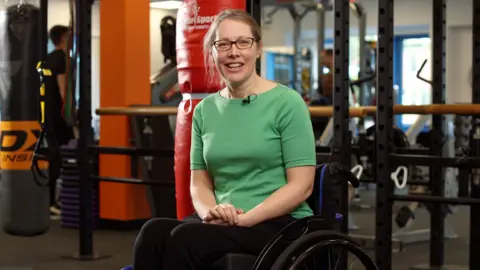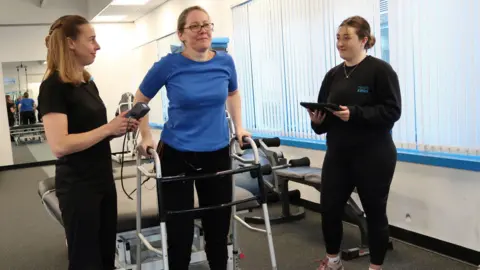'Everybody cried when I was able to walk again'
 PA Media
PA MediaA London woman who was paralysed as a result of an illness has said "everybody cried" when she was able to take her first steps following a pioneering treatment.
Claire Trivedi, 48, was paralysed from the waist down in 2017 when a group of abnormal blood vessels in her spinal cord burst.
She recently received a type of spinal cord stimulation during a small clinical trial, which enabled her to take a few steps using a walker.
"I dreamed that one day I might take a few steps, and my dream came true," the mother of two said.
The study, which involved 10 people between 21 and 68 with varying levels of spinal cord injury, aimed to assess new technology that works by stimulating the "dormant" spine below the patient's injury with electrical pulses.
This was then combined with intensive tailored physical therapy.
While taking part in the trial Ms Trivedi said she saw some functions return that were thought to be lost after her injury.
"I was told my injury was complete, and I just had to get used to my situation, but I refused to give up," she said.
"About 10 weeks before I finished the trial, I took my first steps just using a walking frame, without any leg supports. Everyone cried."
 PA Media
PA Media"I was putting my all into the trial and was being rewarded," Ms Trivedi added.
"Even though it was really slow, I could see improvements. My legs were getting stronger, and I had hope.
"Although all the gains haven't continued, I definitely think the stimulation had a massive impact on my rehab."
All the participants in the Pathfinder 2 trial, which was funded by the charity Spinal Research, took part for more than a year at Neurokinex rehabilitation facilities in the UK and had 120 sessions.
They made improvements in their upper body strength, trunk control and balance - and some also saw improvement in hand grip, dexterity and lower body functions.
Researchers said the improvements did not plateau, which suggested further benefits may be achieved with extended treatment.
Therapy 'not a silver bullet'
Jane Symonds, co-investigator of the study, said: "It's hoped that if somebody, for example, is trying to get some muscle activity in their legs to be able to stand or walk, that when the stimulation is in place... those nerve impulses are more likely to reach their target destination and hopefully enable people to use those muscles.
"It has the potential to be a game-changer, and we're hoping that it's a real breakthrough for people with spinal cord injury."
Spinal Research chair Tara Stewart said: "This therapy is not a silver bullet - it works on spared spinal tissue, so results will vary widely, and it does need to be paired with proper active rehabilitation over a consistent period of time."
Study co-investigator Jenny Suggitt added: "Participants who have completed the study at this point are seeing changes in their motor function - so their standing ability, walking, core control and sensation changes, as well as changes to their autonomic function - so bladder, bowel and sexual function."
The results of the study were published in the journal Neuromodulation: Technology At Neural Interface.
Listen to the best of BBC Radio London on Sounds and follow BBC London on Facebook, X and Instagram. Send your story ideas to [email protected]
